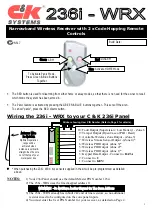
25
5.1 Wiring devices
Connect all mains units to the devices, only tightening the cap nut manually. Do not connect the mains
units to the mains outlet.
Connect deactivated
QuickSelects
with a cat-6 cable (AWG 23), connect link output of the first device to
the link input of the next QuickSelect 3.0, proceed accordingly until all devices are connected in series.
Connect playback device to the HDMI output or to the HDBT Link-out of the last
QuickSelect
in the
series. Only if ring setup is required connect the HDBT Link-out of the last Quickselect to the first unit‘s
Link-in.
5.2 Manual device address awarding
Using a flat-head small screwdriver set both BCD switches on the backside of the QuickSelect units to
individual addresses between 01…98. Address 00 is reserved exclusively for the special case of a ring
circuit, in which case this address must be assigned to only the “first” unit in the ring.
5.3 Automatic device address awarding (address “99“)
Alternatively to manual address awarding according to 5.2 the addresses of all units can awarded
automatically. Make sure that in this case all BCD switches must be kept in their default position “99”.
Only in ring circuit set the “first” unit’s address to “00”. We recommend using the free configuration
software. If the software is not at hand proceed as follows:
Plug all mains units except for the first one in the chain into the mains socket. Plug the supplied Quick-
Setup jumper into the socket
“VGA“ at the rear of the first device
. Now plug the mains unit of the first
device into the mains socket. During the address awarding the LEDs of the signal inputs on the front
light-up 3x several times. Remove the Quick-setup jumper.
Producing your own Quick-setup jumper:
Connect the KEY and GND contacts of an enclosed 3-pin screw/
plug connection terminal with a wire jumper.
5.4 Reading and saving EDID information of playback devices
The
QuickSelect
uses AUTO EDID to read the resolution timings from the last display device in the chain
via the HDBT- or HDMI connection and saves them in all
QuickSelects
. We recommend using the free
configuration software. If the software is not at hand proceed as follows:
Plug all mains units
except for the first one in the chain
into the mains socket. Plug the supplied Quick-
Setup jumper into the socket
“HDMI2“
at the rear of the first device. Now plug the mains unit of the first
device into the mains socket. During the EDID reading and writing process the LEDs of the signal inputs
on the front light-up 3x several times.
Remove the Quick-setup jumper
.
The EDID information is now saved in all HDMI signal inputs of the devices. The EDID information is used
to automatically adjust the resolution of the graphics card of the signal encoder (e. g. laptop) to the
resolution of the playback device (e. g. projector).
5.5 Chain or ring setup?
QuickSelect’s underlying so-called “HDBT” extender technology is capable of simultaneously
transmitting video and audio signals, as well as RS232 control signals and 100Mbps Ethernet. Video and
audio signals are transmitted unidirectional – similar to a “one-way street” – from one unit’s Link-out to
the following Quickselect’s Link-in up to the end of the chain or to the display device. In opposite to that
RS232 information and Ethernet is transmitted in a bi-directional way. Thus a video signal being fed into
the chain at a random unit can only pass successive units, not preceding units.
For a typical meeting room application doing the wiring in “chain topology” is the best choice, because
in this scenario usually only a single display device is used at the end of the chain and the HDBT signal
can be fed directly into a compatible projector. Even showing a signal on more than one display device is
possible, as long as they are located at the end of the chain.
In special cases like for example IT training rooms, when routing a video signal from a random
Quickselect
unit to all other participants is required (including preceding participants), ring setup is
appropriate.











































